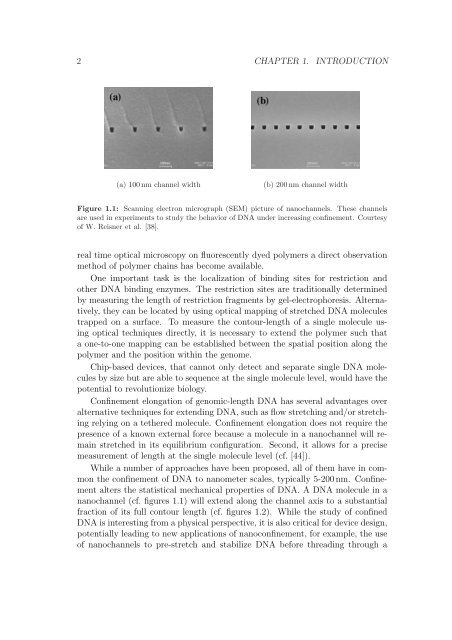Polymers in Confined Geometry.pdf
Polymers in Confined Geometry.pdf
Polymers in Confined Geometry.pdf
You also want an ePaper? Increase the reach of your titles
YUMPU automatically turns print PDFs into web optimized ePapers that Google loves.
2 CHAPTER 1. INTRODUCTION<br />
(a) 100 nm channel width (b) 200 nm channel width<br />
Figure 1.1: Scann<strong>in</strong>g electron micrograph (SEM) picture of nanochannels. These channels<br />
are used <strong>in</strong> experiments to study the behavior of DNA under <strong>in</strong>creas<strong>in</strong>g conf<strong>in</strong>ement. Courtesy<br />
of W. Reisner et al. [38].<br />
real time optical microscopy on fluorescently dyed polymers a direct observation<br />
method of polymer cha<strong>in</strong>s has become available.<br />
One important task is the localization of b<strong>in</strong>d<strong>in</strong>g sites for restriction and<br />
other DNA b<strong>in</strong>d<strong>in</strong>g enzymes. The restriction sites are traditionally determ<strong>in</strong>ed<br />
by measur<strong>in</strong>g the length of restriction fragments by gel-electrophoresis. Alternatively,<br />
they can be located by us<strong>in</strong>g optical mapp<strong>in</strong>g of stretched DNA molecules<br />
trapped on a surface. To measure the contour-length of a s<strong>in</strong>gle molecule us<strong>in</strong>g<br />
optical techniques directly, it is necessary to extend the polymer such that<br />
a one-to-one mapp<strong>in</strong>g can be established between the spatial position along the<br />
polymer and the position with<strong>in</strong> the genome.<br />
Chip-based devices, that cannot only detect and separate s<strong>in</strong>gle DNA molecules<br />
by size but are able to sequence at the s<strong>in</strong>gle molecule level, would have the<br />
potential to revolutionize biology.<br />
Conf<strong>in</strong>ement elongation of genomic-length DNA has several advantages over<br />
alternative techniques for extend<strong>in</strong>g DNA, such as flow stretch<strong>in</strong>g and/or stretch<strong>in</strong>g<br />
rely<strong>in</strong>g on a tethered molecule. Conf<strong>in</strong>ement elongation does not require the<br />
presence of a known external force because a molecule <strong>in</strong> a nanochannel will rema<strong>in</strong><br />
stretched <strong>in</strong> its equilibrium configuration. Second, it allows for a precise<br />
measurement of length at the s<strong>in</strong>gle molecule level (cf. [44]).<br />
While a number of approaches have been proposed, all of them have <strong>in</strong> common<br />
the conf<strong>in</strong>ement of DNA to nanometer scales, typically 5-200 nm. Conf<strong>in</strong>ement<br />
alters the statistical mechanical properties of DNA. A DNA molecule <strong>in</strong> a<br />
nanochannel (cf. figures 1.1) will extend along the channel axis to a substantial<br />
fraction of its full contour length (cf. figures 1.2). While the study of conf<strong>in</strong>ed<br />
DNA is <strong>in</strong>terest<strong>in</strong>g from a physical perspective, it is also critical for device design,<br />
potentially lead<strong>in</strong>g to new applications of nanoconf<strong>in</strong>ement, for example, the use<br />
of nanochannels to pre-stretch and stabilize DNA before thread<strong>in</strong>g through a













